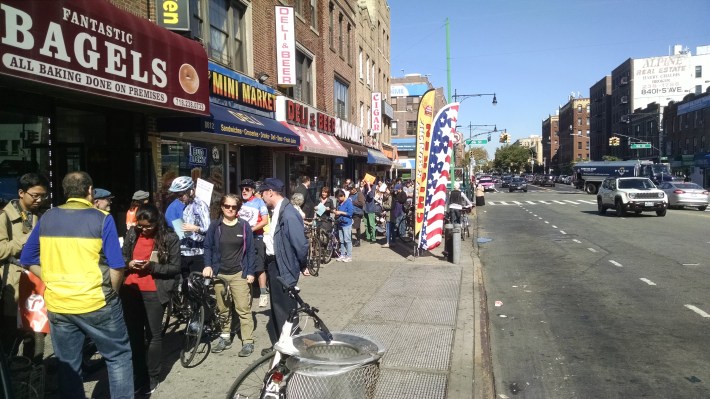![A preliminary MTA report pegged the cost of building bicycle and pedestrian paths on the Verrazano Bridge at $300 to $400 million. Image: MTA [PDF]](https://lede-admin.nyc.streetsblog.org/wp-content/uploads/sites/48/2016/10/VNB_PATH.png?w=710)
Later this year, the MTA will release a master plan for the Verrazano Bridge that's expected to include the possibility of a bike and pedestrian path, but advocates worry the agency is needlessly driving up the cost of the project.
The Verrazano was built at the tail end of the Robert Moses era, and it infamously provides no way for people to cross by walking or biking. Recently, advocates under the banner of the Harbor Ring Committee have pressed the MTA to rectify that mistake, and their momentum is building: A path has the support of nearly every elected official on both the Brooklyn and Staten Island sides of the bridge.
The MTA has installed bike racks on some of the buses that cross the bridge each day, but while popular, the program is no substitute for a path. Each bus can only hold two bikes at a time.
On Saturday, advocates organized a direct action at the last Brooklyn bus stop before the bridge. To call attention to the limitations of the racks, activists lined up with their bikes at the S53 bus stop and asked the bus driver if they could put their bikes on the rack and board.
“We had a line down the block," said Mike Lydon, who lives in Brooklyn and who serves on the leadership of the Harbor Ring Committee. "It was a real mix between locals in the neighborhood, cycling activists from across Brooklyn, and we certainly had a number of people from Staten Island."

While the final master plan has not been released, a preliminary report published last year by the MTA and Parsons Brinckerhoff pegged the cost of building bicycle and pedestrian paths at $300 to $400 million [PDF]. That's significantly higher than the inflation-adjusted $60 million that the Department of City Planning estimated the project would cost in 1997. (That plan proposed placing the paths between the bridge's suspender cables, which consultants said would not be feasible.)
The MTA could shave off a big chunk of the cost by simplifying the design of the approach on the Brooklyn side, according to Greg Mihailovich, Transportation Alternatives' Staten Island organizer. "There are definitely ways to keep the cost down," he said. "There’s a practical aspect to it. If you can build a useful path for half that then that’s something you have to consider."
Mihailovich and Lydon are skeptical that the MTA will release its plan before 2017, but MTA spokesperson Ortiz told AMNY last week that the end-of-year deadline had not changed.
"We're in a holding pattern waiting to see how seriously they’re approaching a multi-use path on the bridge," Mihailovich said. "We’re waiting for clarity on a lot of these questions of cost... then it’s a question of hopefully convincing [MTA and elected officials] that this is worthwhile endeavor, because there certainly are people who need to use this path."





